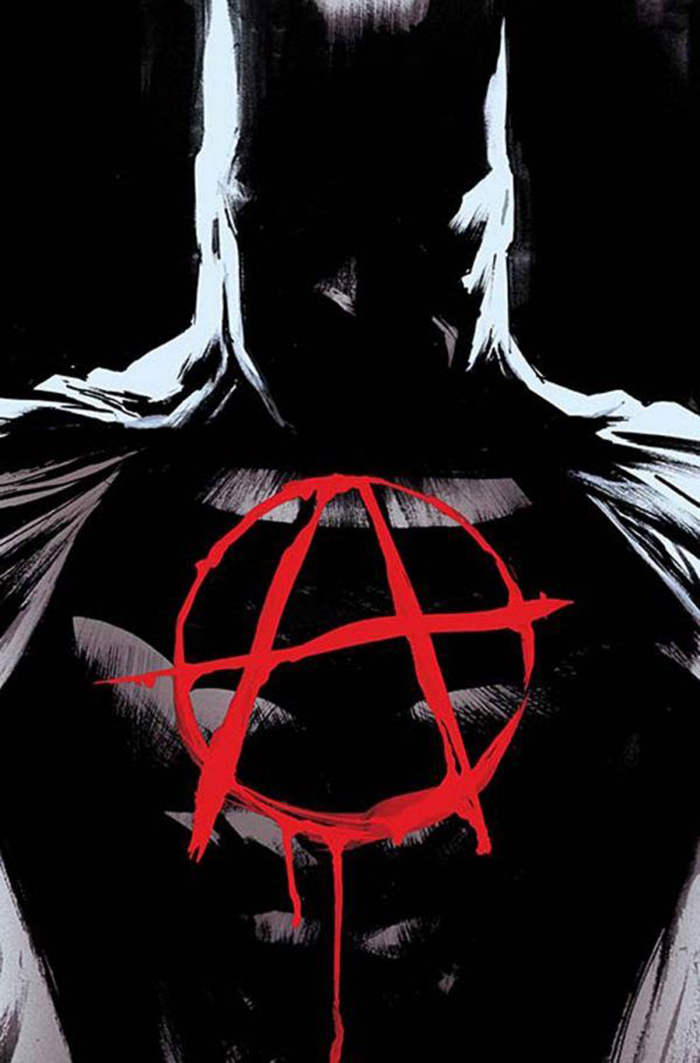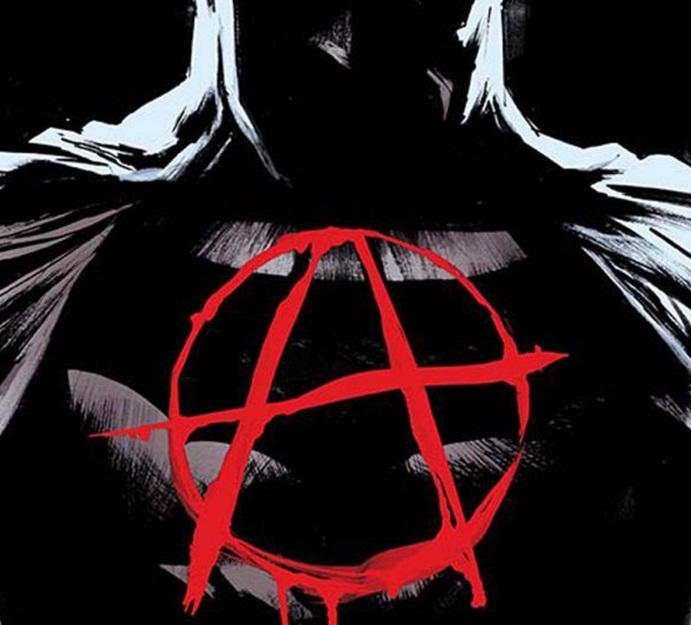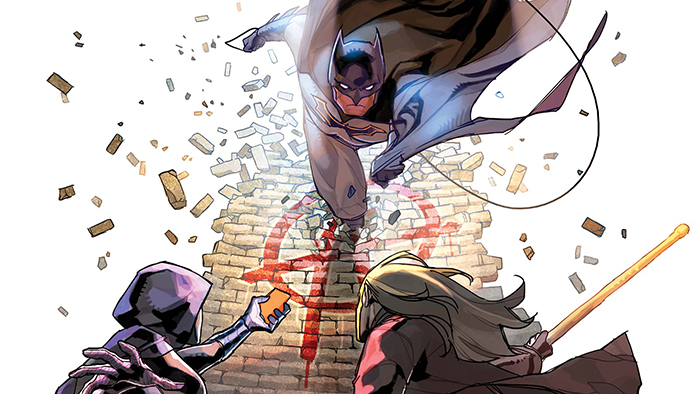
Welcome to Part Two of a retrospective look at the history of Anarky, who is officially back in the pages of Detective Comics—having appeared in Detective Comics #957, #963 and #964 (which releases tomorrow) by James Tynion IV and Carmen Carnero. The first part of DC’s long and complex experiment in overtly politicizing superhero comics via a foil for Batman lasted from 1989 to 2011 (with a few hiatuses here and there), but it didn’t simply end when the Modern Age of comics gave way to the New 52. Let’s take a gander at Anarky’s influence on comics in the past six years, but if you haven’t checked out the first part of the history of Anarky, head over here to learn now.
In 2013, Anarky saw his first action outside of a comic book, appearing as the primary antagonist in the animated TV show Beware the Batman. This version of the character contained some similarities to the original Anarky, but was rendered more as a Professor Moriarty-esque villain than any sort of anti-hero. Also in 2013, Anarky made his video game debut in Batman: Arkham Origins. This version of the character was more in tune with the anti-corporate anarchist roots that Anarky had in the early 90s. In 2015, Anarky made his live action TV debut in Arrow, played by Alexander Calvert, once again as a more pure super-villain stereotype.

With Anarky popping up in different media around 2013, it was only a matter of time before he sprung back into the pages of the New 52. With DC having been fully rebooted and Batman getting a brand new origin story (“Zero Year”) courtesy of Scott Snyder, there was a blank slate for Anarky. In 2014, writer Van Jensen (along with a rather large creative team of Robert Venditti, Victor Drujiniu, Ivan Fernandez, Allan Jefferson, Juan Castro, Rob Lean, and Garry Henderson) delivered a brand new version of Anarky in Green Lantern Corps Vol. 3 #25. In the issue, set during Batman’s first year in costume, a super-storm heads towards Gotham, which has been blacked-out by Riddler. A team of marines, including Sergeant John Stewart (future Green Lantern), helps evacuate an arena full of Gothamites. There, the soldiers discover an anarchist group—led by Anarky—has reclaimed “people’s ownership” of the arena, despite a portion of the people having been forced to go along with his plan. While Stewart despises Anarky’s methods, he sees that Anarky means well and winds up siding with him against his own army brethren, who attempt to quell the situation with unnecessary lethal force. Stewart stops his crazed lieutenant and frees the hostages without causing any deaths. Meanwhile, Anarky escapes clean. Afterward, Stewart punches-out his lieutenant, effectively ending his military career.
While the new Anarky seemed to reflect what made him so popular in the early 90s, a big change in the character was making him black. Jensen said he wanted to do “a fresh take that honors [Anarky’s] legacy.” An African-American Anarky seemed to do just this, giving a minority voice to the ultimate social justice warrior, especially in a situation that closely resembled the aftermath of Hurricane Katrina in New Orleans. Not only that, but juxtapositioning him with John Stewart, one of the most recognizable black DC heroes, and then having Stewart give a wink and a nod to Anarky, was a big boon to the character. Jensen and company even interspersed Green Lantern Corps Vol. 3 #25 with a flashback to Stewart’s childhood in Detroit, showing corrupt racist police reaction to left wing labor unionists. All of this was done to give sympathy to and legitimize Anarky’s political point of view. Unfortunately, Jensen’s Anarky was a big tease. Despite being well-received, this version of Anarky would not be seen again, making this a one-off one-shot appearance, much to the chagrin of fans, who were generally excited about this take.

In 2014, Francis Manapul and Brian Buccellato—via their “Icarus” arc (Detective Comics Vol. 2 #30-34) and follow-up “Anarky” arc (Detective Comics Vol. 2 #37-40)—would do their own take on the character. In “Icarus,” Bruce meets with Elena Aguila, who wants his help in reconstructing the slummy East End Waterfront property purely as a positive social act despite the fact that it would be a financial disaster for Wayne Enterprises. Bruce meets with Elena at her daughter Annie’s pro motocross event. There, Elena appeals to Bruce’s philanthropic side and he agrees to work with her “Healthy Families Initiative”—to put social interest ahead of corporate interest. In doing so, Bruce shuns corrupt Congressman Sam Young who had proposed a less socially progressive, more corporate-friendly reconstruction plan. This all leads to Elena’s death and Batman attempting to get the bizarre drug known as Icarus off the streets, a case that culminates in the complete destruction of the East End Waterfront. With plans so save the waterfront ruined, Annie angrily storms off. In the wreckage of the East End, Bullock and his partner Nancy Yip go to retrieve the remaining crate of the Icarus drug, but in its place is a spray-painted anarchy symbol. Anarky is back in Gotham!

By 2015, Manapul and Buccellato had successfully built an intriguing mystery. Who was Anarky? Could the new Anarky be socially progressive and kick-ass motocross-riding Annie Aguila? Or could it be Jensen’s awesome African-American anti-hero? (Sorry, I already spoiled that it wasn’t him.) Manapul and Buccellato continued their story with the Detective Comics arc entitled “Anarky,” adding another perfect candidate: Lonnie Machin! Thanks to references in Detective Comics Vol. 2 #38, we were given some New 52 backstory: Years ago, a tech genius calling himself Moneyspider hacked into Wayne Enterprises’ airtight computer system. Batman tracked Moneyspider and exposed him as pre-teen prodigy Lonnie Machin. Feeling sorry for both Lonnie and his down-and-out mom, Bruce decided not to press charges. Batman had been watching over Lonnie ever since. The idea that Lonnie could be returning as a rebooted Anarky in 2015 was quite exciting.
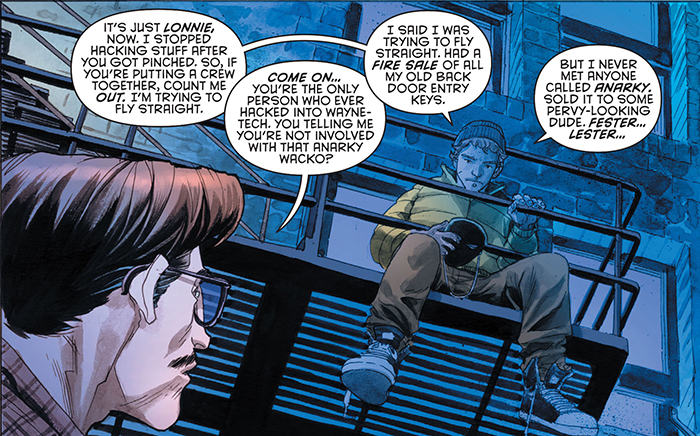
In the “Anarky” arc, the unknown Anarky executes corrupt business exec Jeb Lester. Meanwhile, Batman apprehends an escaped Mad Hatter and discovers that Jervis Tetch had been secretly killing kids even before his debut as Mad Hatter. Bullock (who has been tracking Anarky for months), Yip, and Batman investigate the scene of Lester’s murder, when, all of a sudden, the building’s computer systems lock-down and a bomb goes off, scorching a giant anarchy symbol into the façade of the structure. On Christmas morning, Anarky announces that he has erased the digital footprint of everyone in Gotham, making it so all police records, bank records, and credit debt are completely erased. Anarky declares that social revolution has begun. The next morning, Sam Young pledges support to Anarky, claiming there is method in his madness, especially compared to the right wing Mayor Hady. Batman interrogates Lonnie, citing that only he could have accessed control of Wayne Tower. Machin admits to the hack job, but says he gave the info to Lester, not Anarky. Later, during a robbery incited by Anarky’s words, innocent bystander Lonnie gets shot and is rushed to the hospital. Batman and Bullock find a link between Tetch and Young, which brings them to an abandoned boarding house. There, the heroes realize that those emboldened by Anarky have been influenced by Mad Hatter mind-control tech as well. They also learn that Tetch was a groundskeeper that terrorized and killed the kids at the boarding house, including a young Anarky. Anarky tries to kill Mad Hatter, but Batman stops him and punches his mask off…
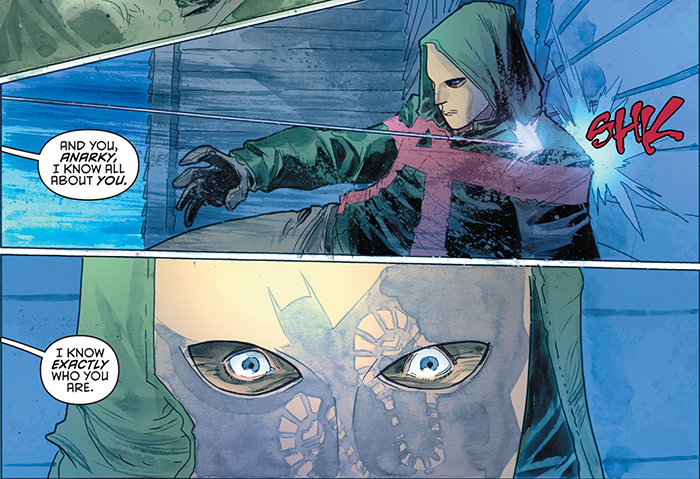
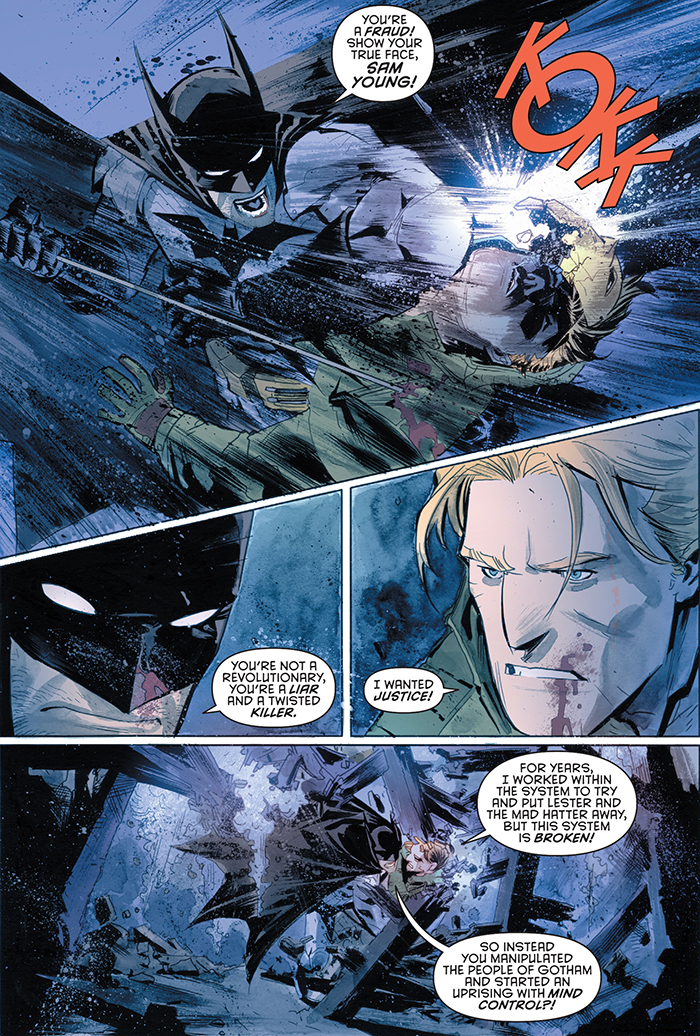
And with so many good directions to choose from, it is at this point that Manapul takes the pro wrestling route, delivering a twist just to swerve the audience. (Although, to be fair, this was the direction they had planned from the beginning.) Anarky was the jerk that upheld corporate values at the expense of the poor, a dude in the pocket of both Big Business and gangsters: Sam Young. Acting as a copycat of Jensen’s Anarky from “Zero Year” and using the famous Gotham anti-hero’s moniker for his own twisted purposes, Young was our new Anarky. The story continues with Batman and Bullock saving the day and busting Anarky. Thankfully, Lonnie makes a full recovery. In regard to politics, Manapul’s Anarky talked the talk, but he didn’t walk the walk, instead opting to using anarcho-socialist activism and rhetoric to mask ulterior criminal motives—albeit a somewhat sympathetic justice-oriented personal revenge scheme.

In 2015, the New 52 also gave us our first female Anarky, the alternate Anarky of Earth-2, a super-villain seen in five issues of Earth-2: Society. Similarly to Manapul’s Anarky, this version also espouses anti-authoritarian politics and rhetoric, but only to mask criminal activity that has nothing to do with social justice. For example, Earth-2’s Anarky—created by Daniel H. Wilson and Jorge Jimenez—blows up a building to access a spacecraft engine, then instigates a protest riot to cover her tracks. This also turns out to be part of a dastardly scheme by the villain Doctor Impossible.
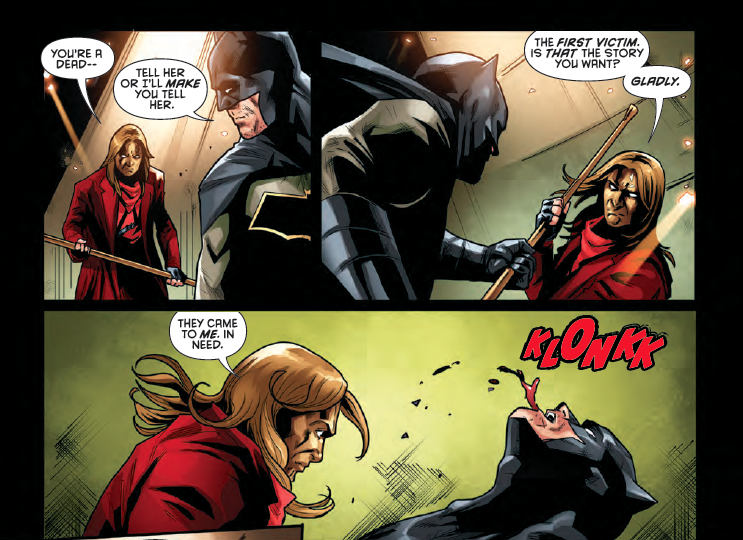
And that brings us up to speed. Detective Comics #957 and Detective Comics #963-964, part of DC’s Rebirth reboot, saw Anarky return once more, this time to lend a hand to Spoiler, who is estranged from the Bat-Family. An wouldn’t you know, Tynion and Carnero have returned Lonnie Machin behind the mask! In issues #963-964 we catch a glimpse at the good work Anarky is doing. He’s set up an underground anarcho-syndicalist farming commune—called Utopia—for Gotham’s poor and destitute. The commune has a tent city, solar lighting, and greenhouses. After all, as Twitter user @SemperLiber9 says, “Anarchism is a mix of community gardening and punching Nazis.” Notably, pure heroic characters Harper Row and Leslie Thompkins are a part of this movement. Spoiler herself is so moved, she not only joins the movement, but becomes romantically involved with Anarky…for a brief moment. Batman exposes a dark criminal connection between Anarky and a super-villain called The First Victim, giving the Dark Knight all the reason he needs to throw Lonnie behind bars. Anarky is relegated to quasi-villain status yet agin, although his good work lives on in the form of the commune. At the end of ‘tec #964, Anarky—using his Moneyspider skills—hatches a plot that should see him out of Arkham in the near future.
Based upon Tynion’s work on Detective Comics and already what we’ve seen in Detective Comics #963-964, the new version of Anarky should be in more than capable hands, should he visit the DCU again. Despite Anarky’s clash with Batman and immediate jailing, a return to Lonnie (and his urban farming commune) implies a return to the character’s roots. And there’s no better time for Anarky in superhero comics than right now. Anarky can be the symbol he was meant to be at his inception—a force for good, social equity, real justice, and justice for all. Comic book universes are fantastical and far-fetched, but they are meant to reflect the world in which we live. And in 2017 America, where the President won’t effectively denounce Nazis and the KKK, choosing to instead pander to them as a constituency, Anarky is the hero we need. In 2017 America, where the alt-right and white supremacists are emboldened in ways they haven’t been in a long time, Anarky is the hero we need. In 2017 America, where systemic racism plagues our law enforcement agencies and the prison industrial complex is tantamount to slavery, Anarky is the hero we need.

Through the lens of a modern Anarky—treated as a sophisticated social justice revolutionary that upholds the values of Emma Goldman, Malcolm X, and Martin Luther King while picking up the pieces of the shattered Occupy movement and bearing the banner of Black Lives Matter or Antifa—Tynion has a great opportunity to re-introduce an antihero that is a stalwart and uncompromising defender against fascism, unchecked militarism, sexism, racism, homophobia, systemic police corruption, economic corporate despotism, and class oppression. If Tynion’s reboot of Anarky acts as this defender while fighting for the basic public provision of education, health care, and housing and while also incorporating the concept detailed in the Tim Drake monologue from Detective Comics #946—the idea that superheroes should earn the public trust through collaboration and rehabilitation—Anarky has the potential to be one of the most culturally relevant characters of the 21st century. As Alan Grant and Norm Breyfogle once showed decades ago, Anarky is the perfect tool to address these types of ideas in comics. And now is the perfect time for them to be addressed.
